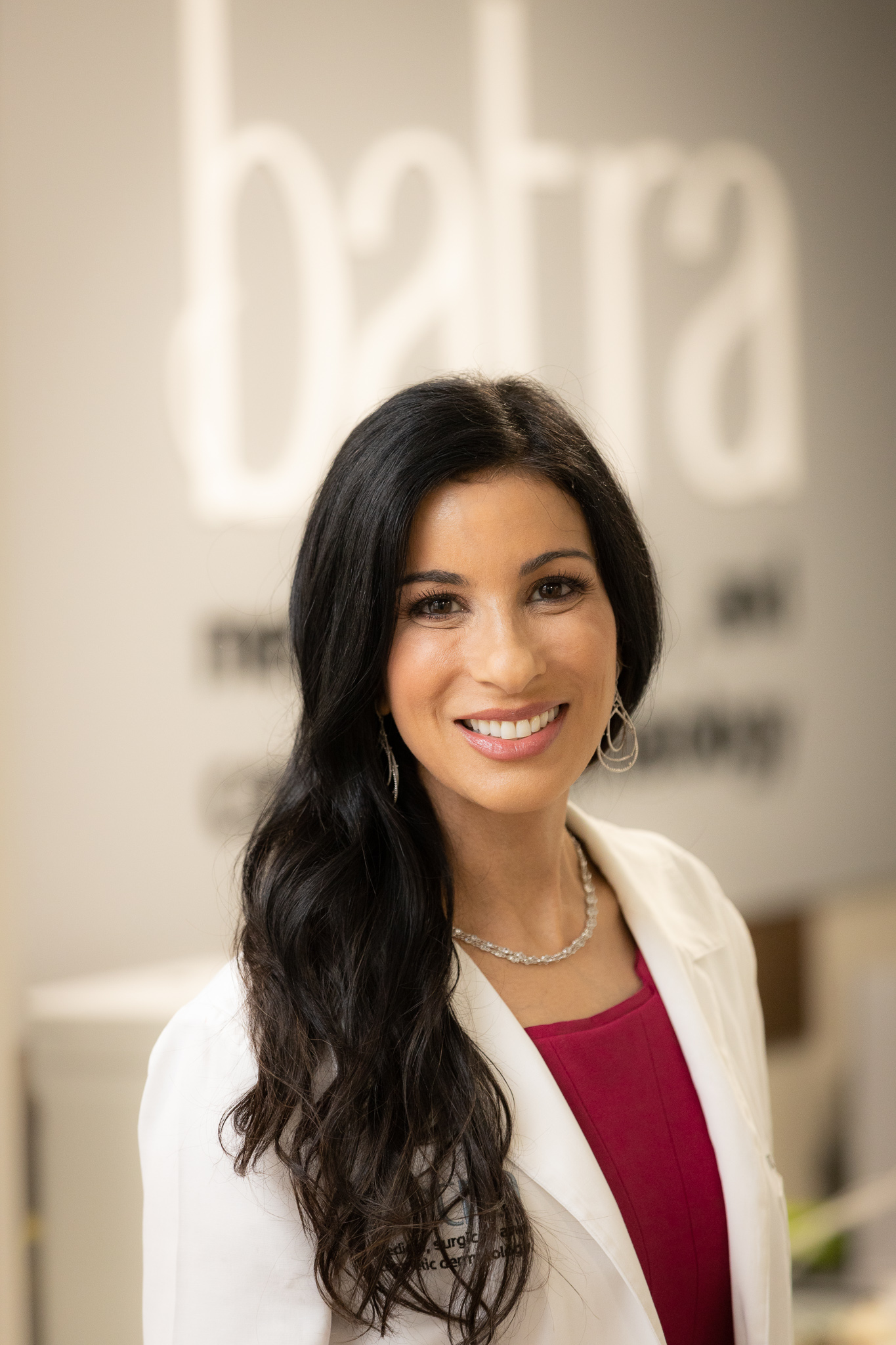This Anti-Aging Laser Could Help Fight Skin Cancer
Good skin and good health? NAFL treatments may offer both.

When you think of laser treatments, you probably picture brighter skin and fewer wrinkles. But what if that same zap of light energy could help lower your risk of skin cancer? According to a recent study, nonablative fractional laser (NAFL) treatments—long beloved by dermatologists for their rejuvenating effects and one of the top minimally invasive cosmetic procedures in the U.S.—may offer surprising protection against keratinocyte carcinoma, which encompasses the U.S.' most common nonmelanoma skin cancers, by stimulating skin healing and increasing skin cell turnover.
This discovery could be a game-changer, especially considering the stakes: Over five million new keratinocyte carcinoma cases are diagnosed annually in America, says Dr. Brian Hibler, a board-certified dermatologist in New York City and one of the authors of the aforementioned study. “We need better risk mitigation strategies, especially for those with fair skin and a history of significant sun exposure who are at highest risk for developing these skin cancers,” he says.
Nonablative lasers might just be dermatology’s ultimate friend with benefits. These multitasking machines can tighten skin, smooth fine lines, fade brown spots, and more. “If you're looking for a procedure that's going to kill as many birds with one stone, a nonablative fractional laser is your best bet,” says Dr. Corey L. Hartman, MD, a board-certified dermatologist in Birmingham, Alabama.
In light of new studies on NAFL's role as a preventative treatment against skin cancer, there's all the more reason to schedule an appointment with your favorite dermatologist.
The Benefits of Nonablative Lasers Are More Than Skin Deep
One study examined 43 patients with a history of facial skin cancer who had undergone NAFL treatments, specifically with the Fraxel laser. These results were compared to 52 control subjects (similar in age, gender, and skin type) who had a history of skin cancer but had not received NAFL therapy. What researchers found was striking: Those who had undergone NAFL treatments (the number of sessions varied among the group, but generally once per year is recommended) had a significantly lower risk of developing new skin cancers. Specifically, 20.9 percent of NAFL-treated patients developed a subsequent keratinocyte carcinoma, compared to 40.4 percent in the control group.
Nonablative lasers might just be dermatology’s ultimate friend with benefits.
“This study represents a paradigm shift in how we think about these cosmetic treatments,” Dr. Hibler says. Prior research showed that fully ablative devices (such as CO2 lasers), which essentially burn off the entire outer layer of the skin, could reduce cancer risk. It’s now becoming clear that less aggressive NAFL treatments provide impressive protective benefits minus the downtime and risk, he explains.
How It Works
It may seem too good to be true that a treatment designed to boost collagen and smooth fine lines could also fight cancer, but the hype, at least according to the research, is real. NAFL devices deliver targeted light energy absorbed by water in the skin, creating tiny zones of controlled injury that stimulate healing without destroying the skin’s surface, explains Dr. R. Sonia Batra, a dual board-certified dermatologist and micrographic dermatologic surgeon in Santa Monica, California.
Get exclusive access to fashion and beauty trends, hot-off-the-press celebrity news, and more.
This heat energy “wakes up” fibroblasts—specialized cells responsible for skin structure—which slow down with age, Dr. Batra says. “The laser likely increases the production of a hormone called Insulin-like Growth Factor 1 (IGF-1), which is thought to play an important role in regulating the skin cells and inhibiting UV-damaged skin cells from growing, giving it an anti-cancer effect.”
In short, “rejuvenated skin not only appears more youthful, but it behaves in a more youthful fashion—enhancing cellular repair mechanisms, fighting off mutated cells, and resisting the carcinogenic effects of UV radiation,” Dr. Hibler says.
What's hard to say, however, is whether you can translate the results of Fraxel, which was the device used in the study, to other lasers like HALO and Clear + Brilliant, when you undergo treatment once per year. Dr. Hibler suspects that if the energy settings and wound healing response are the same, you’ll likely have a similar protective effect, but more research is needed.
What to Expect
“Typically, patients will have this performed once per year for annual skincare maintenance,” Dr. Hibler says. (That said, in more mature patients who are trying to correct rather than prevent visible signs of aging, he may do two to three rounds of Fraxel to get them to a good baseline.)
Dr. Hibler uses a combination of laser settings and tailors the treatment to the patient’s skin type and primary concerns. “For example, in areas where they want to build more collagen, we will go more aggressively with the deeper wavelength, such as around the eyes and mouth,” he explains. “Whereas if they have a lot of sun spots and pigmentation, we will use more aggressive settings with the superficial wavelength.”
It may seem too good to be true that a treatment designed to boost collagen and smooth fine lines could also fight cancer, but the hype is real.
Expect about a week of social downtime marked by redness, swelling, and peeling similar to a sunburn. “Let’s just say I wouldn’t want to do this and go to my high school reunion!” Dr. Hartman says.
Gentle cleansers, moisturizers, and rigorous sun protection are non-negotiable during recovery. Costs can vary, but a treatment usually ranges from $850 to $1,500 per session.
The Ideal Candidate
The study focused mainly on patients with Fitzpatrick skin types one through three (primarily type two), meaning fair-skinned individuals who are at the highest risk for sun damage and skin cancer.
While fractional lasers are generally safer than ablative lasers for deeper skin tones, Dr. Hartman recommends that patients with melanin-rich complexions proceed with caution and seek out an “experienced hand” to avert potential risks like burns and hyperpigmentation. “The nice thing about the [1550 nanometer] wavelength that [researchers] found to be most beneficial is that it is considered safe for Fitzpatrick skin types four through six, so it does open up the spectrum of people who can be safely treated preventively,” Dr. Batra says.
One important caveat: NAFL therapy shows promise in reducing basal and squamous cell carcinomas but there’s no current data supporting its effectiveness against melanoma, the most dangerous form of skin cancer. And because the study excluded immunocompromised individuals, further research is needed to see if these benefits extend to this patient population.
Insurance Companies Aren’t on Board (Yet)
Sadly, you’ll have to pay out of pocket to cash in on NAFL devices' protective perks, as insurance companies still classify it as a purely cosmetic procedure. Covered treatments for pre-cancers can include chemical peels, photodynamic therapy, topical chemotherapy creams, and liquid nitrogen—but, of course, none check all the boxes quite like NAFL.
Until more robust data emerges that substantiates the cost-effectiveness of these treatments, NAFL therapy is unlikely to replace traditional skin cancer prevention methods like sunscreen and annual skin checks. However, if it’s within your budget, you can now think of Fraxel as an insurance policy for your face. “This laser will erase signs of sun damage, have a preventative effect by slowing down further signs of aging, and provide protection against skin cancer,” says Dr. Hibler. “This is why I personally do this treatment every year.”
Time to raid your FSA? Perhaps.

Meet the Experts

Corey L. Hartman, MD, FAAD is the founder and medical director of Skin Wellness Dermatology in Birmingham, Alabama. He is Adjunct Associate Professor of Dermatology at the UAB Heersink School of Medicine Department of Dermatology. Dr. Hartman is certified by the American Board of Dermatology and is a fellow of the American Academy of Dermatology, the American Society for Dermatologic Surgery and the American Society for Laser Medicine & Surgery. Patients travel from all over the U.S. to see Dr. Hartman specifically for his expertise in tailoring dermatologic surgery and cosmetic procedures that are safe and effective for patients for all skin types, and he regularly participates in clinical trials to further this work. Dr. Hartman is internationally recognized as an expert on injectable fillers, neuromodulators, hyperpigmentation and social media in dermatology and frequently speaks at meetings around the world on these topics. He is frequently quoted in leading publications including The New York Times, The Wall Street Journal, VOGUE, CNN Underscored, Allure, Women’s Health, PopSugar, Essence, Glamour, Cosmopolitan, InStyle and more, and serves on the boards of many organizations and companies including Editorial Board of the Journal of the AAD, Board of Directors of the Skin of Color Society, Dermatology Times, Men’s Health Magazine, Galderma Aesthetics, Allergan Aesthetics and Revision Skincare.

Dr. Hibler is a board-certified and fellowship-trained medical and cosmetic dermatologist practicing in New York City. He completed his dermatology residency at Memorial Sloan Kettering Cancer Center and New York Presbyterian – Cornell. Following residency, he completed a prestigious fellowship in laser and cosmetic dermatology at Harvard Medical School, Massachusetts General Hospital, and the Wellman Center for Photomedicine, one of the leading laser and cosmetics centers in the world. His cosmetic interests include: acne scar revision, preventative aging, injectables, non-invasive body contouring and tissue tightening, and treatment of sun damage and skin cancer prevention through the use of lasers. Dr. Hibler has received numerous national dermatology awards, authored more than 60 peer-reviewed publications and book chapters, and frequently lectures at national and international conferences.

Dr. Sonia Batra is the founder of a dermatology practice in Santa Monica, CA and a co-host of CBS’ former long-running television show, The Doctors. Dr. Batra received her A.B., M.P.H, and M.D. degrees from Harvard University, where she graduated magna cum laude and was elected to Phi Beta Kappa. As a Rhodes Scholar, she earned a Master's degree at the University of Oxford, England. She completed her residency training in Dermatology at Stanford University followed by advanced fellowship training in Mohs micrographic surgery, laser and cosmetic dermatology. She has been selected as a Top Doctor in Dermatology by Castle Connolly, Los Angeles Magazine and Southern California SuperDoctors. Her husband, Sameer, is a urologist, and they are the proud parents of two teenagers.